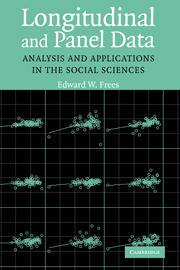Book contents
- Frontmatter
- Contents
- Preface
- 1 Introduction
- 2 Fixed-Effects Models
- 3 Models with Random Effects
- 4 Prediction and Bayesian Inference
- 5 Multilevel Models
- 6 Stochastic Regressors
- 7 Modeling Issues
- 8 Dynamic Models
- 9 Binary Dependent Variables
- 10 Generalized Linear Models
- 11 Categorical Dependent Variables and Survival Models
- Appendix A Elements of Matrix Algebra
- Appendix B Normal Distribution
- Appendix C Likelihood-Based Inference
- Appendix D State Space Model and the Kalman Filter
- Appendix E Symbols and Notation
- Appendix F Selected Longitudinal and Panel Data Sets
- References
- Index
8 - Dynamic Models
Published online by Cambridge University Press: 05 September 2012
- Frontmatter
- Contents
- Preface
- 1 Introduction
- 2 Fixed-Effects Models
- 3 Models with Random Effects
- 4 Prediction and Bayesian Inference
- 5 Multilevel Models
- 6 Stochastic Regressors
- 7 Modeling Issues
- 8 Dynamic Models
- 9 Binary Dependent Variables
- 10 Generalized Linear Models
- 11 Categorical Dependent Variables and Survival Models
- Appendix A Elements of Matrix Algebra
- Appendix B Normal Distribution
- Appendix C Likelihood-Based Inference
- Appendix D State Space Model and the Kalman Filter
- Appendix E Symbols and Notation
- Appendix F Selected Longitudinal and Panel Data Sets
- References
- Index
Summary
Abstract. This chapter considers models of longitudinal data sets with longer time dimensions than were considered in earlier chapters. With many observations per subject, analysts have several options for introducing more complex dynamic model features that address questions of interest or that represent important tendencies of the data (or both). One option is based on the serial correlation structure; this chapter extends the basic structures that were introduced in Chapter 2. Another dynamic option is to allow parameters to vary over time. Moreover, for a data set with a long time dimension relative to the number of subjects, we have an opportunity to model the cross-sectional correlation, an important issue in many studies. The chapter also considers the Kalman filter approach, which allows the analyst to incorporate many of these features simultaneously. Throughout, the assumption of exogeneity of the explanatory variables is maintained. Chapter 6 considered lagged dependent variables as explanatory variables, another way of introducing dynamic features into the model.
Introduction
Because longitudinal data vary over time as well as in the cross section, we have opportunities to model the dynamic, or temporal, patterns in the data. For the data analyst, when is it important to consider dynamic aspects of a problem?
Part of the answer to this question rests on the purpose of the analysis. If the main inferential task is forecasting of future observations as introduced in Chapter 4, then the dynamic aspect is critical. In this instance, every opportunity for understanding dynamic aspects should be explored.
- Type
- Chapter
- Information
- Longitudinal and Panel DataAnalysis and Applications in the Social Sciences, pp. 277 - 317Publisher: Cambridge University PressPrint publication year: 2004



